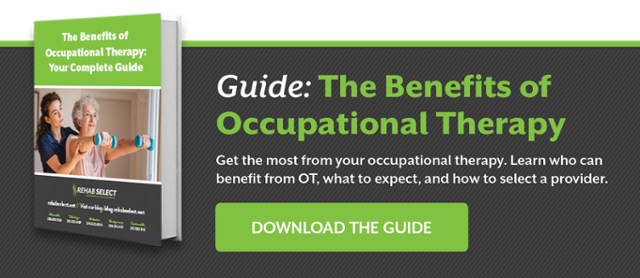
Physical and occupational both play a key role in rehabilitation and recovery. At Rehab Select, our expert teams of occupational and physical therapists work together to create a holistic treatment program for our patients in short- and long-term care.
If you’ve been referred for a combination of occupational and physical therapy, you might be wondering why you need both types of therapy. In this article, we’ll address how physical and occupational therapies complement each other, and how they each contribute to patient well-being and recovery.
Why do some patients need both physical therapy and occupational therapy?
Physical therapy and occupational therapy share similar goals. They both aim to help patients recover from medical conditions, surgery, or injury as quickly and safely as possible. However, the approach of each school of therapy differs slightly, and so for many patients, both types of therapy are recommended.
Physical Therapy vs. Occupational Therapy
In general, physical therapists focus on mobility and function. Specifically, physical therapy targets what are called “gross motor skills” – the movements of the large muscles of the arms, legs, and torso. People with impaired gross motor function will struggle with whole-body movements, such as standing up, walking, running, jumping, or climbing. Physical therapists will try to help improve their patients’ strength, balance, and coordination.
Occupational therapists, by contrast, focus more on their patients’ ability to perform daily tasks, such as self-care, social interaction, working, or living independently. They will typically concentrate on fine motor skills using the smaller muscles of the hands, feet, mouth and face, and on cognitive abilities.
For many patients, both physical therapy and occupational therapy will be required to help them recover their quality of life and full motor function. For instance, a patient recovering from a stroke might well need physical therapy to relearn how to stand, walk and climb stairs. That same patient can also benefit from occupational therapy to help them feed themselves and perform other daily self-care tasks.
Which patients benefit from occupational therapy?
Occupational therapy is of particular benefit to those patients whose medical conditions have significantly impaired their ability to function in their day-to-day lives. For example, occupational therapy is typically recommended to the following groups:
- Patients recovering from major surgery, such as joint replacement or orthopedic surgery
- People rehabilitating after a stroke
- Patients who are recovering from a heart attack or other serious cardiac event
- Anyone who has lost significant mobility and function in their daily lives due to a chronic health condition or serious accident
- Patients with chronic severe pain
- People with neurological conditions, such as cerebral palsy or multiple sclerosis
- Those with serious joint impairment, such as rheumatoid arthritis
- People suffering from hand conditions, like carpal tunnel syndrome
It’s worth noting that, despite the name, occupational therapy is not necessarily related to the patient’s ability to work. Occupational therapists have a broader focus, addressing the patient’s capacity to complete daily tasks and routines. They focus on the whole person and their quality of life, not simply their capacity to return to the workplace.
What do physical and occupational therapy have in common?
While occupational therapy and physical therapy have significant differences, they also have a great deal in common. In particular, the two forms of treatment share:
Similar Treatment Goals
It’s possible to argue that occupational therapy and physical therapy have different agendas. For instance, some definitions of the two schools of therapy suggest that physical therapy helps to rectify impairments or limitations; whereas, occupational therapy aims to help people live with and manage their limitations.
However, although the focus may be slightly different, physical therapists and occupational therapists are essentially working towards the same ends:
- Helping patients recover physical motor skills, function, and strength
- Improving their patients’ quality of life
- Encouraging patients’ independence as much as possible
- Supporting patients and their families
- Providing patients with the knowledge and confidence they need to manage their own recovery
Shared Treatment Methods
Physical therapy and occupational therapy use different treatment techniques, but there are some protocols that are common to both approaches. For instance:
- Manual therapy techniques, such as massage or hot and cold therapy
- Therapeutic stretching
- Progressive strengthening exercises
- Training in the use of adaptive equipment
Conditions
While the treatment focus is different, occupational and physical therapy are often appropriate for the same physical conditions and impairments, such as:
- Amputation
- Improving mobility after an injury
- Recovery after surgery
- Neurological conditions
- Brain damage
- Stroke
- Cancer
- Chronic pain
Settings
Physical and occupational therapy usually take place in similar locations, such as:
- Rehab treatment centers
- Long-term nursing facilities
- Hospitals
- Clinics
- In the patient’s home
Approach to Treatment
Physical and occupational therapists share a similar attitude and approach towards patient care. For instance:
- Both types of therapy will be based on a comprehensive, customized treatment plan for each patient.
- Both are highly specialized rehabilitative treatments and require extensive professional training and certification.
- Both approaches take a holistic, whole-person view of the patient’s treatment, with the overall aim of improving the individual’s quality of life and physical capability, not simply addressing a single symptom.
- Both physical therapists and occupational therapists aim to build a strong support network for patients by working closely with family members and other caregivers to inform and educate them on the patient’s long-term needs.
- Both physical and occupational therapists will closely monitor the patient’s progress throughout treatment and adapt the therapy to suit each individual’s needs and abilities.
How do physical and occupational therapists work together?
During a rehabilitative treatment program, physical and occupational therapists will work together to help patients identify goals and then use their specific treatment protocols to help patients achieve those goals. For instance, if a patient has the goal to be able to walk again after a stroke, their physical therapist will help them address this objective by working on their strength, endurance, balance, and gait.
The occupational therapist will also support this goal by focusing on exercises that will be useful in daily life, such as reaching for items from a cabinet, or getting in and out of bed. In other words, physical therapy focuses on the biomechanical aspects of walking, while occupational therapy focuses on the practical applications of being able to walk.
These two types of therapists collaborate using assistive devices and modifications. For instance, if a patient has trouble with balance and coordination, the physical therapist might help them learn how to use a walker to get around more easily. At the same time, an occupational therapist could supplement this gross motor support with equipment to help with fine motor skills, such as teaching the patient to use a reaching device to pick up items on the floor and avoid falling. They would also help patients adapt how they do things in everyday life, such as getting dressed one-handed.
At Rehab Select, our team of physical, occupational, and speech therapists work closely together to offer a personalized and rigorous schedule of treatments, with the aim of helping patients recover faster and experience a better quality of life. If you’d like to visit one of our facilities, please just click here to schedule a tour.




